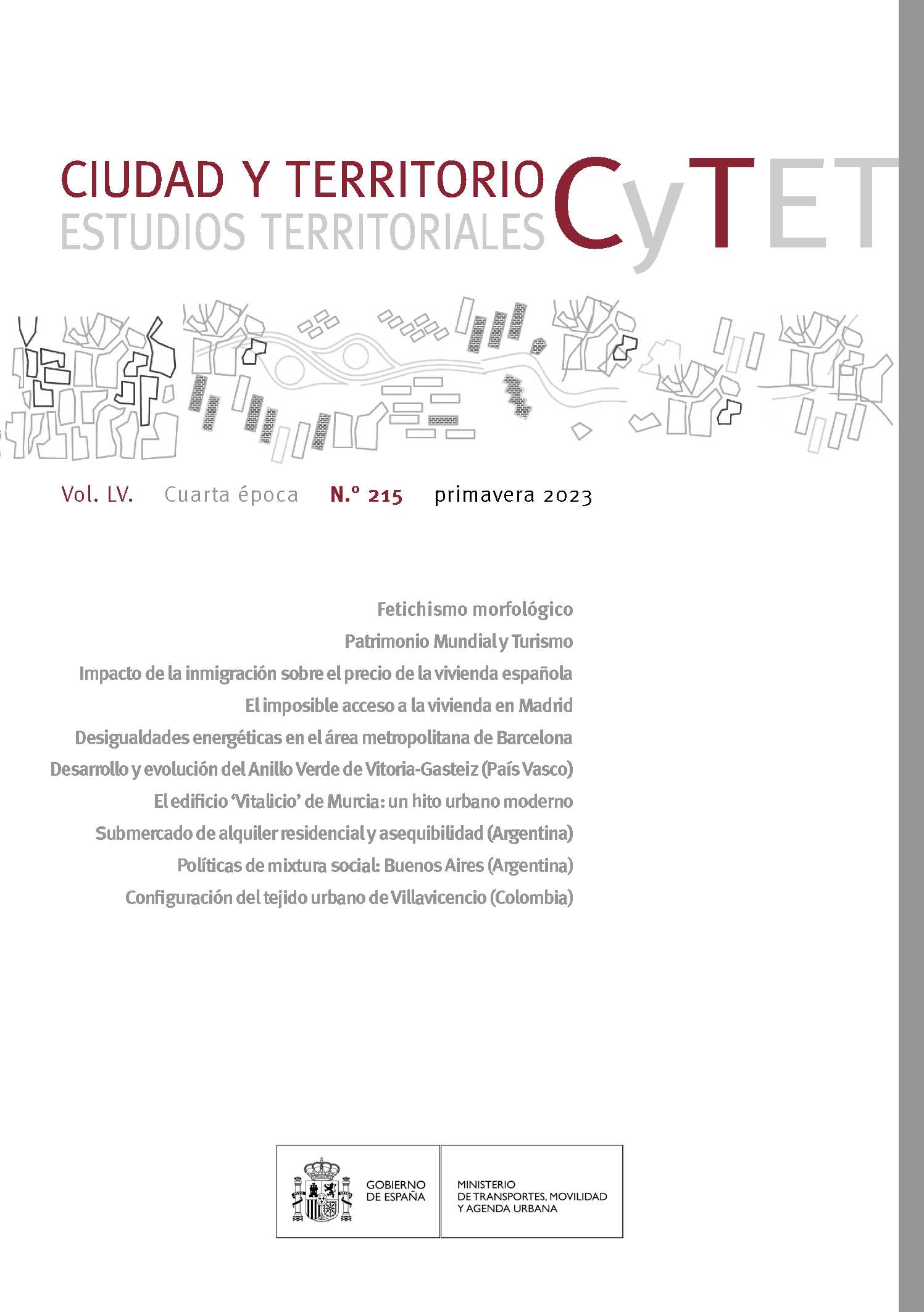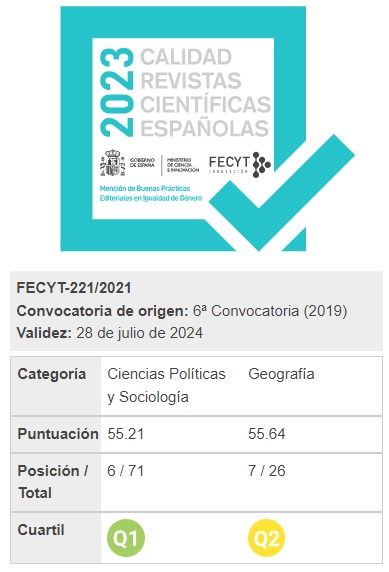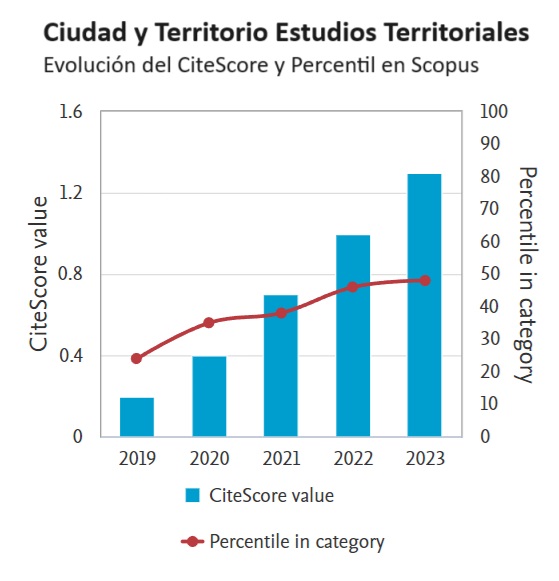Social mixing policies, a trend or a solution to the housing problem?:an analysis of two case studies in the Metropolitan Area of Buenos Aires (Argentina)
DOI:
https://doi.org/10.37230/CyTET.2023.215.9Keywords:
Social mixing, Housing policy, State Housing, Urban regeneration, Upgrading slums, Buenos AiresAbstract
We explore the processes that gave rise to the recent housing policies of "residential social mix" and "urban regeneration" in the Metropolitan Area of Buenos Aires (Argentina), as well as the characteristics that their designs and implementations assumed. We will do so based on two case studies: one of state-built housing built on the unfinished route, in a peri-central area of the City of Buenos Aires, zone currently undergoing a process of urban renewal, and another of state-built housing as part of the re-urbanisation of a popular neighbourhood in the Municipality of Avellaneda (Province of Buenos Aires). Through interviews with different population profiles, we investigated the potential and limitations of this type of intervention, problematizing to what extent it is oriented towards the production of a more egalitarian city or constitutes enabling discourses of exclusionary practices
Downloads
References
Aramburu F. (2020): Los Programas Federales de Vivienda y las estrategias de adquisición de suelo urbano para su concreción: un análisis desde el caso del Municipio de Avellaneda en el Conurbano Bonaerense (2005-2015). Tesis para optar por el título de magister. Los Polvorines: Universidad Nacional de General Sarmiento.
Arbaci, s. & Rae, I. (2014): Efecto barrio y desigualdades: evidencias para desmitificar las políticas urbanas de diversificación residencial. ACE: Arquitectura, Ciudad y Entorno. 9(26): 147-176.
Bauder, H. (2002): Neighbourhood effects and cultural exclusion. Urban Studies, 39 (1): 85-93.
Baumont, C. (2007): Neighborhood effects, urban public policies and housing values: a spatial econometric perspective. Université de Bourgongne.
Carman, M. & Vieira Da Cunha, N. & Segura, R. (2013): Segregación y diferencia en la ciudad. Quito. Ecuador: FLACSO.
Clichevsky, N. (2003): Pobreza y acceso al suelo urbano. Algunas interrogantes sobre las políticas de regularización en América Latina. Santiago de Chile: CEPAL.
Cravino, M. C. (2006): Las villas de la ciudad: mercado e informalidad urbana. Los Polvorines, Universidad Nacional de General Sarmiento.
Cuenya, B. (2004): Fragmentos sociales. Buenos Aires: Editorial Siglo XXI.
Darcy, M. (2013): From high-rise projects to suburban estates: Public tenants and the globalised discourse of deconcentration. Cities, 35: 365-372.
Delgadillo, V. (2011): Patrimonio Histórico y Tugurios. Ciudad de México: UACM.
Díaz, M. & Zapata, M. C. & Aguilar, D. & Fernández, O. & Quiroga, A. (2019): ¿Normativa urbana para quién? El caso del nuevo barrio Parque Donado-Holmberg, Ciudad de Buenos Aires, Argentina. Revista de Geografía Estudios Socioterritoriales, 25: 1-25.
Di Virgilio, M. M. & Brikman, D. (2019): Nuevas derechas, nuevas políticas de urbanización: el modelo pro en la Ciudad de Buenos Aires y el caso de Villa 15. Oculum Ensaios, 16(2): 215-234.
Fainstein, N. (1993): Race, class, and segregation: discourses about African-Americans, International Journal of Urban and Regional Research, 17, pp. 384– 403.
Fernandes, E. (2003): Perspectivas para a renovação das políticas de legalização de favelas no Brasil. En P. Abramo (org); A cidade da informalidade. O desafio das cidades latino-americanas. Rio de Janeiro: Livraria Sette Letras; FAPERJ.
Giroud M. (2019): Mezcla, control social y gentrificación. Territorios. 41: 295-304.
González Redondo, C. (2022): Los desarrolladores inmobiliarios en los procesos de renovación urbana. Reflexiones a partir de la creación del barrio Donado Holmberg en Buenos Aires. En XIV Seminario Internacional de Investigación en Urbanismo. Madrid.
Guevara, T. (2014): La renovación como estrategia de desarrollo urbano en Buenos Aires (1996-2011). Apuntes, 26(2), 68-79.
Guevara, T. (2015): Abordajes teóricos sobre las transformaciones sociales, económicas y territoriales en las ciudades latinoamericanas contemporáneas. EURE. 41(124): 5-24.
Herzer, H. M. (coord.) (2008): Con el corazón mirando al sur: Transformaciones en el sur de la ciudad de Buenos Aires. Buenos Aires: Espacio Editorial, Buenos Aires.
Hughes, M.A. (1989): Misspeaking truth to power: A geographical perspective on the “underclass” fallacy. Economic Geography, 65(3), 187-207.
Jargowsky, P. A. (1996): Take the Money and Run: Economic Segregation in U.S. Metropolitan Areas. American Sociological Review, 61(6), 984–998.
Najman, M. (2020): ¿Vivir mejor? Análisis de las trayectorias hacia la vivienda social y las transformaciones sobre las situaciones de exclusión de sus habitantes. Tesis Doctoral. Buenos Aires: Facultad de Ciencias Sociales, Universidad de Buenos Aires.
Oszlak, O & O'Donnell, G. (1981): Estado y Políticas Estatales en América Latina: Hacia una estrategia de investigación. Buenos Aires: CEDES – CLACSO.
Prévôt Schapira, M. F. (2001): Fragmentación espacial y social: conceptos y realidades. Perfiles latinoamericanos: revista de la Facultad Latinoamericana de Ciencias Sociales, Sede México. 9(19), 33-56.
Prévôt Schapira, M. F. (2002): Buenos Aires en los años 90: metropolización y desigualdades. EURE, 28(85): 31-50.
Rodríguez, M. C., & Di Virgilio, M. M. (2011): Caleidoscopio de las políticas urbanas. Un rompecabezas para armar. En M. M. Di Virgilio (Ed.), Caleidoscopio de las políticas territoriales. Un rompecabezas para armar. Buenos Aires: Prometeo Libros.
Ruiz-Tagle, J. (2016): La segregación y la integración en la sociología urbana: revisión de enfoques y aproximaciones críticas para las políticas públicas. Revista INVI, 31(87), 9-57.
Ruiz-Tagle, J. & Romano, S. (2019): Mezcla social e integración urbana: aproximaciones teóricas y discusión del caso chileno. Revista INVI, 34(95), 45-69.
Sabatini, F. (2003): La segregación social del espacio en las ciudades de América Latina. Serie Azul, 35(2003), 59-70.
Sabatini, F. & Edwards, G. & Cubillos, G. & Brain, I. & Mora, P. & Rasse, A. (2010): Dispersión espacial de vivienda económica como vía de integración social urbana. Camino al Bicentenario: propuestas para Chile. Santigo de Chile: Concurso políticas públicas.
Slater, T. (2013): Your life chances affect where you live. A critique of the ‘cottage industry’ of neighbourhood effects research. International Journal of Urban and Regional Research, 37(2).
Smets, P. & Salman, T. (2008): Countering urban segregation: Theoretical and policy innovations from around the globe. Urban Studies, 45(7).
Sibley, D. (1995): Geographies of Exclusion: Society and Difference in the West. London: Routledge.
Soldano, D. (2013): Confinamientos, movilidad e intercambios. Una investigación sobre las condiciones y modos de vida en la periferia del Gran Buenos Aires. Segregación y diferencia en la ciudad. Quito: Flacso, Clacso y Miduvi.
Theodore, N. & Peck, J. & Brenner, N. (2009): Urbanismo neoliberal: la ciudad y el imperio de los mercados. Temas sociales, 66(10).
Vale, L. J. (2013): Purging the poorest: Public housing and the design politics of twice-cleared communities. Chicago, IL: University of Chicago Press.
Vergara Erices, L. A. (2019): ¿Construyendo comunidad de barrio?: mixtura y cohesión social en los proyectos de integración social en Chile. Andamios. Vol 16(40): 275-298.
Watt, P. (2013): Official and critical urbanist discourses on regeneration and social housing estates. En RC21 Conference, Berlin.
Watt, P. (2017): Social housing and urban renewal: An Introduction. En P. Watt & P. Smets (Eds.). Social housing and urban renewal: A cross-national perspective (pp. 1-36), Bingley: Emerald Group Publishing.
Wilson, J. (1987): The truly disadvantaged. Chicago, IL: The University of Chicago Press.
Zapata, M.C. (2017): La política habitacional porteña bajo la lupa. De los programas llave en mano a la autogestión del hábitat. Buenos Aires: Edit. Teseo.
Zapata, M.C & González Redondo, C. & Najman, M. & Corti, F. (2021): Políticas habitacionales de mixtura social en escenarios de renovación urbana. El caso del Plan de Soluciones Habitacionales en la traza de la Ex Autopista 3 (Ciudad de Buenos Aires, Argentina). Cuadernos de Geografía: Revista Colombiana de Geografía. Vol. 30(1): 45-65.
Zapata, M.C & Belluscio S. (2018): De la Autopista 3 al Barrio Parque Donado-Holmberg (Buenos Aires, Argentina): Una larga disputa por el espacio urbano. Quid16, Revista del Área de Estudios Urbanos. 9: 60-90.
Published
How to Cite
Issue
Section
License
Copyright (c) 2022 Mercedes Najman

This work is licensed under a Creative Commons Attribution-NonCommercial-NoDerivatives 4.0 International License.
Considering the provisions of the current legislation on Intellectual Property, and in accordance with them, all authors publishing in CyTET give -in a non-exclusive way and without time limit- to the Ministry of Transport, Mobility and Urban Agenda the rights to disseminate, reproduce, communicate and distribute in any current or future format, on paper or electronic, the original or derived version of their work under a Creative Commons Attribution-NonCommercial-NoDerivative 4.0 license International (CC BY-NC-ND 4.0), as well as to include or assign to third parties the inclusion of its content in national and international indexes, repositories and databases, with reference and recognition in any case of its authorship.
In addition, when sending the work, the author(s) declares that it is an original work in which the sources that have been used are recognized, committing to respect the scientific evidence, to no longer modify the original data and to verify or refute its hypothesis. Author(s) also declare that the essential content of the work has not been previously published nor will it be published in any other publication while it is under evaluation by CyTET; and that it has not been simultaneously sent to another journal.
Authors must sign a Transfer of Rights Form, which will be sent to them from the CyTET Secretariat once the article is accepted for publication.
With the aim of promoting the dissemination of knowledge, CyTET joins the Open Journal Access (OA) movement and delivers all of its content to various national and international indexes, repositories and databases under this protocol; therefore, the submission of a work to be published in the journal presupposes the explicit acceptance by the author of this distribution method.
Authors are encouraged to reproduce and host their work published in CyTET in institutional repositories, web pages, etc. with the intention of contributing to the improvement of the transfer of knowledge and the citation of said works.








 Enlace a CyTET en Linkedin
Enlace a CyTET en Linkedin